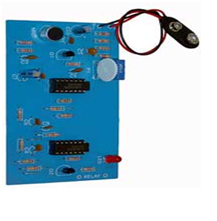Asheekay
Member
Out of the 3 cupboards I use in my home, there's one that also holds items sometimes needed by others.
This cupboard, I would like to be able to unlock from afar, without using manual keys, of course.
After thinking and trying a few options including:
1- disassembling and scavenging a small drone quadcopter for its remote controlled part (and failing miserably at it)
2- using several models of remote electronic car lock gadgets (they turned out to have only a range of up to 10 meters max)
I finally came up with the idea of somehow controlling it with a cellphone. For one, cellphones have infinite range (provided service availability of course) and the usage is pretty easy (you just call or message, right?). Initial research revealed that I have two options for the project:
1- manual approach (which I like), which turns on the lock's dc motor if there's input on the cellphone's speakers
2- digital approach, using an arduino uno, which does the same thing, but also has option for operating it through a specific message. While providing far better control, his is also far more complex for me, hence not the preferred method
So now the question is, how can I turn on a 12v dc motor just by calling on my cell number? I have an old B&W nokia to spare for this job.
I have tried connecting the speaker cables directly to the motor, but that doesn't even rotate the shaft at all. I guess I will have to power the motor separately through a 12v battery and somehow trigger it from the cellphone's speaker cables. And this is where I need help. What I have in mind currently is this:

What I need help about is:
1- Is this circuit practically applicable?
2- Should I indeed use a transistor to switch on the motor as compared to a relay? I have checked that the cellphone speakers cables provide a maximum of 3v, 100 mA power. Will a relay turn on at all at this power?
3- And finally, go on and tell me that the transistor will fuse away due to excess current. Which resistor(s) do I need to use in this setup (or any that you suggest) to keep it going?
This cupboard, I would like to be able to unlock from afar, without using manual keys, of course.
After thinking and trying a few options including:
1- disassembling and scavenging a small drone quadcopter for its remote controlled part (and failing miserably at it)
2- using several models of remote electronic car lock gadgets (they turned out to have only a range of up to 10 meters max)
I finally came up with the idea of somehow controlling it with a cellphone. For one, cellphones have infinite range (provided service availability of course) and the usage is pretty easy (you just call or message, right?). Initial research revealed that I have two options for the project:
1- manual approach (which I like), which turns on the lock's dc motor if there's input on the cellphone's speakers
2- digital approach, using an arduino uno, which does the same thing, but also has option for operating it through a specific message. While providing far better control, his is also far more complex for me, hence not the preferred method
So now the question is, how can I turn on a 12v dc motor just by calling on my cell number? I have an old B&W nokia to spare for this job.
I have tried connecting the speaker cables directly to the motor, but that doesn't even rotate the shaft at all. I guess I will have to power the motor separately through a 12v battery and somehow trigger it from the cellphone's speaker cables. And this is where I need help. What I have in mind currently is this:
What I need help about is:
1- Is this circuit practically applicable?
2- Should I indeed use a transistor to switch on the motor as compared to a relay? I have checked that the cellphone speakers cables provide a maximum of 3v, 100 mA power. Will a relay turn on at all at this power?
3- And finally, go on and tell me that the transistor will fuse away due to excess current. Which resistor(s) do I need to use in this setup (or any that you suggest) to keep it going?

